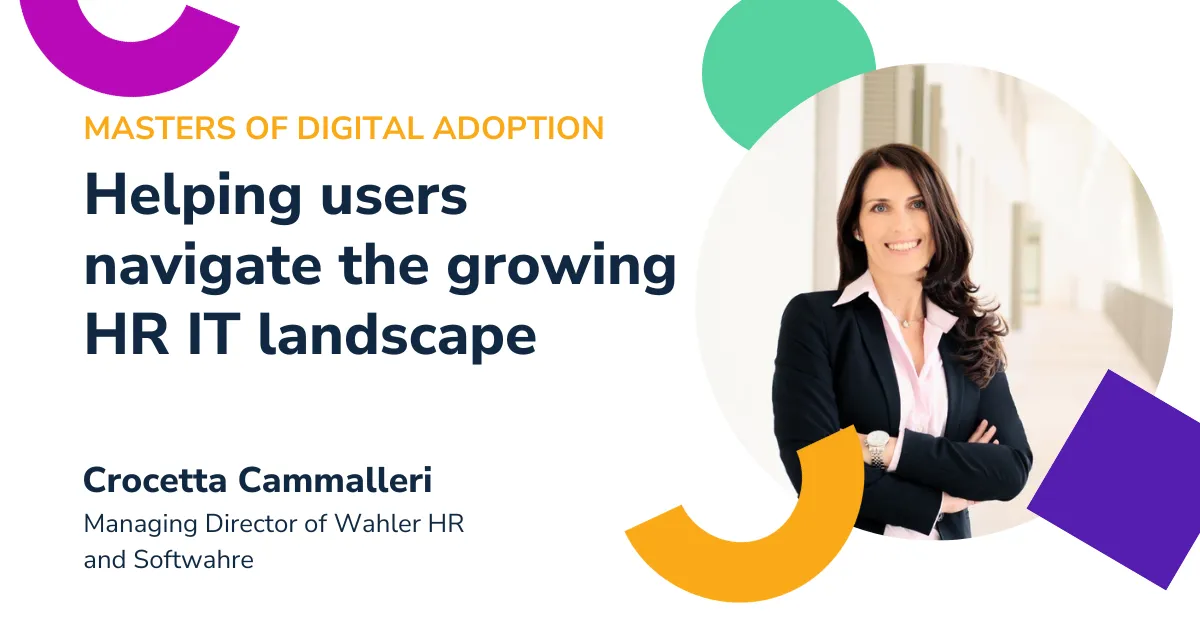Helping users navigate the growing HR IT landscape

Userlane partners, Softwahre GmbH, are HR digitizers and experts in implementing different HR softwares and digitizing HR functions.
In our latest Masters of Digital Adoption series, we spoke with Crocetta Cammalleri, Managing Director at Softwahre to about the issue of digital adoption within the manufacturing industry. A particularly pertinent topic due to the often complex IT infrastructures in place, and a workforce who are typically slow to adopt new technologies.
My current role as Managing Director of Wahler HR and Softwahre, allows me to live out my great passion for the digitization of HR organizations. I am convinced that the right HR software makes our work and decision-making processes much easier. My team and I support companies in all issues related to the digitization of HR in order to offer all employees a comprehensive range of HR services that are digitally supported and tailored to their needs. In our opinion, this is one of the most important success factors for motivating, engaging and retaining employees.

Table of Contents
Manufacturing has unique challenges when it comes to digital adoption
For the manufacturing industry, digital adoption is crucial. This is due to the many benefits it offers, such as increased efficiency, heightened productivity, more flexibility and employer attractiveness. However, the manufacturing industry also faces unique challenges in adopting digital technologies:
Complexity of HR IT landscape
At the present time, various HR systems are being implemented to meet complex requirements seen in the areas of workforce and time management, payroll, employee secondment and learning requirements. This means the mapping of many interfaces, complexity for user empowerment (a lot of new tools) and complex implementation projects (less resources for Change management and training). This means a lot of training is required, which impacts both managers and users resources.
Data management and security
Employees in production facilities often do not have their own mobile devices and use shared terminals or are not allowed or do not want to use their private devices. This requires a special examination of data protection to enable these employees to access the HR systems.
Skilled workforce
The adoption of digital HR technologies requires a skilled workforce. The manufacturing industry still faces a shortage of skilled workers with expertise in digital technologies. Many manufacturing processes are still manual, which can make it challenging to employees who are not used to working with IT systems.
Cultural resistance to change
Many manufacturing companies have a traditional mindset and .This can make it challenging to implement new HR technologies and processes.
People first approach is highly necessary to overcome these challenges
Digital adoption is essential for the manufacturing industry to remain competitive in today’s digital age.
Working in production facilities with rigid working hours and shift models is often less attractive for the new generation. In times of a shortage of skilled workers, the attractiveness of the employer with needs-based digitization solutions on offer is an important success factor in attracting and retaining employees.
However, it requires needs-based HR IT solutions that reach all employees and have a consistently positive impact on the user experience.
Consider beyond the go-live date
Often, the preparation of managers, HR and employees for working with the new software and accompanying changes is underestimated. By this I mean that in the time leading up to the go-live, everything often revolves around the technical implementation.
HR is very busy translating and configuring the requirements in the new software and making everything possible so that everything works on the go-live date.
In the process, we observe that the integration of all stakeholders in the company often takes place too late or is overwhelmed with a multitude of training dates packed with new processes and information.
A considered approach to implementing new technology, with a focus on digital adoption
For manufacturing organizations, I would recommend the following key business considerations in your HR digitization journey:
- Choosing the right HR software is the initial step that needs to be considered, and as part of that there are questions that need to be asked. Will the software add value? Will employees adapt to, and adopt the new software easily? Will it integrate within the HR IT landscape that is already in place?
- Quantifying the added value of the software to build a business case. There needs to be a clear and defined approach to making sure the changes are tangible and you set yourself up to achieving it in the end.
- An understanding of the impact that the introduction of new HR systems can have on day-to-day business, as it’s likely to equal additional work for employees on top of their existing workload. This is especially true when there is a lack of experience when complex HR IT landscapes are introduced.
- The integration and engagement of all employees plays a huge factor in the success of any new technology being introduced, and should be considered early on in the process to ensure a sustainable application of the systems for all users, regardless of IT affinity.
- Building new competencies in the HR organization to continuously develop IT systems and services, to configure them themselves, to build sophisticated predictive analytics, to work with the existing data.
- Classic training courses take time and often employees forget a lot of what they learn over time. Especially if the HR systems are not used every day or if new employees must be trained again due to regular job changes. With a Digital Adoption Platform, like Userlane, the interactive process guides the user through the training and actively supports during the execution of the processes in the HR systems. Training in advance is therefore no longer necessary. This saves time, resources and is even more fun for users.
- Regular analysis of the user experience and thus also the added value across all HR systems. This means that necessary adjustments in digital HR processes can be made based on actual application usage data and dissatisfaction with the HR systems can be identified and rectified quickly. Userlane helps with the Heart Analytics functionalities to give such kinds of insights across the whole HR IT landscape.
Thinking beyond the technical go-live date is essential for success. Ensuring employees can use the software in the correct way without it impacting their day-to-day jobs too heavily is when you will realize the value of a HR implementation.
At Softwahre, we work with tools like Userlane to help users learn and navigate digital HR systems, apps, and software quickly and effectively. These platforms are designed to enhance the user experience by providing users with guidance and support throughout their digital journey.
My one piece of advice for mastering digital adoption…
The user experience for everyone in the company should be one of the most important goals in HR digitization. With Userlane this is easy, efficient and sustainable to support.

